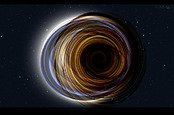This article is more than 1 year old
Grav wave boffins are unsure if they just spotted the smallest black hole or the biggest neutron star seen yet
Mysterious object's mass has challenged astrophysics models
Astronomers have detected what could be either the tiniest black hole or the largest neutron star found to date.
Gravitational waves are emitted when two massive objects collide and merge with one another. The energy of the impact event ripples through spacetime, and these signals are detected by measuring the movement of mirrors in laser interferometers.
Several gravitational wave events have been confirmed since their discovery in 2015, but none of them are as unusual as the one reported in a paper published Tuesday in The Astrophysical Journal Letters.
The source of the collision is between a black hole of 23 solar masses and a mysterious, unknown object of 2.6 solar masses. "We don't know if this object is the heaviest known neutron star, or the lightest known black hole, but either way it breaks a record," said Vicky Kalogera, co-author of the study and a professor at Northwestern University.
The gravitational wave merger, codenamed GW190814, occurred following a collision between an object about nine times heavier than the other – the largest difference in mass detected yet.
Theoretical models have predicted that neutron stars have an upper limit of about two solar masses, while black holes in binary systems are never smaller than about five solar masses. There seemed to be no objects that exist in between these limits, an observation that astronomers have called a "mass gap". Now, the latest gravitational wave detection has challenged that idea and researchers aren't quite sure what the object with 2.6 solar masses is.
"It's a challenge for current theoretical models to form merging pairs of compact objects with such a large mass ratio in which the low-mass partner resides in the mass gap," Kalogera said. "This discovery implies these events occur much more often than we predicted, making this a really intriguing low-mass object.
"The mystery object may be a neutron star merging with a black hole, an exciting possibility expected theoretically but not yet confirmed observationally. However, at 2.6 times the mass of our sun, it exceeds modern predictions for the maximum mass of neutron stars, and may instead be the lightest black hole ever detected."
The researchers failed to find any signs that the small object was tidally locked to its larger black hole companion, which would indicate that it is, indeed, a neutron star, according to Mario Spera, a Marie Curie Fellow at the University of Padova and currently working at Northwestern University. "We did not find any 'tidal imprint' in the gravitational-wave signal, and we did not even detect any light from the event. This already gives us some insights on the possible absence of a neutron star," he told El Reg.
"Moreover, theoretical models for neutron-star matter and observations of the population of neutron stars with electromagnetic astronomy, allow us to estimate the maximum mass that a neutron star can attain. These predictions suggest that the lighter compact object is probably too heavy to be a neutron star, and is therefore more likely to be a black hole."
Some neutron stars, such as pulsars, emit electromagnetic energy from their magnetic poles. Spera said that scientists could try to confirm whether the object was a neutron star or a black hole by looking out for similar gravitational waves with the Laser Interferometer Gravitational-Wave Observatory (LIGO) in Louisiana and the Virgo interferometer in Italy.
The GW190814 merger happened around 800 million light years away from Earth in a region towards the Sculptor constellation in the Southern Hemisphere. ®

